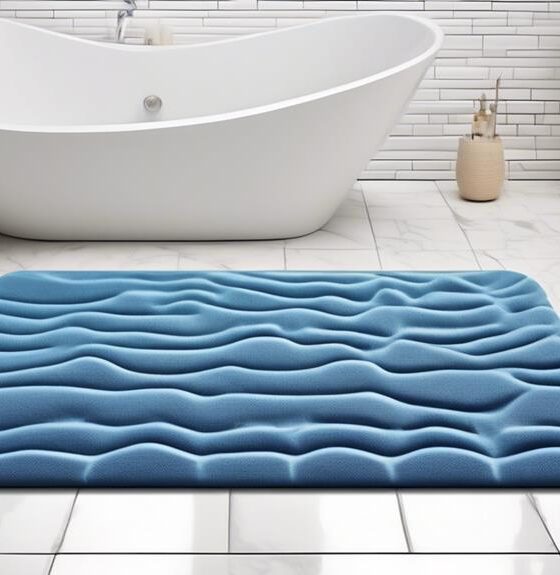Retreat
How to Make a Spa at Home

Did you know that 80% of people feel stressed on a regular basis?
If you’re looking for ways to relax and unwind without leaving the comfort of your own home, we’ve got you covered.
In this article, we’ll show you how to create a spa-like experience right in your own bathroom.
From setting the mood with soothing music and lighting to indulging in DIY facial treatments and aromatherapy, we’ll guide you through the steps to transform your home into a personal sanctuary of relaxation.
Key Takeaways
- Creating a relaxing atmosphere with dim lights, soft music, and candlelight
- DIY facial treatments using homemade face masks and gentle facial massage
- Aromatherapy with essential oils for stress relief and skin benefits
- Indulging in a soothing bath with essential oils and luxurious bath products
Setting the Mood: Creating a Relaxing Atmosphere
We often find that dimming the lights and playing soft music can create a truly relaxing atmosphere for our home spa experience. When it comes to setting the mood, candlelight meditation and a calming music playlist are essential.
The gentle flickering of candlelight creates a warm and intimate ambiance, perfect for unwinding and indulging in self-care. Find candles with soothing scents like lavender or vanilla to enhance relaxation.
Next, curate a calming music playlist that includes serene melodies and gentle rhythms. Music has the power to soothe the mind and transport us to a state of tranquility. Choose songs that resonate with your personal preferences and create a serene atmosphere.
As you immerse yourself in candlelight meditation and listen to the soothing tunes, you’ll feel the stress melt away, allowing you to fully embrace the spa experience in the comfort of your own home.
DIY Facial Treatments: Pamper Your Skin at Home
Luckily, there are plenty of affordable and effective DIY facial treatments that can pamper our skin right in the comfort of our own homes. When it comes to facial massage techniques, gentle upward strokes using our fingertips can help improve blood circulation and promote a healthy glow. We can start at the center of our face and move outwards, focusing on our forehead, cheeks, and jawline.
Another great way to indulge in a spa-like experience is by using homemade face masks. These masks can be easily made using ingredients from our kitchen, such as honey, yogurt, and avocado. Honey acts as a natural moisturizer, while yogurt helps exfoliate and brighten the skin. Avocado, on the other hand, nourishes and hydrates, leaving our skin feeling soft and supple.
Aromatherapy: Using Essential Oils for Ultimate Relaxation
To enhance our relaxation experience, we can incorporate aromatherapy by using essential oils. Essential oils are highly concentrated plant extracts that have been used for centuries for their therapeutic properties. They can be blended together to create unique and customized scents that promote relaxation and rejuvenation.
One of the benefits of aromatherapy is its ability to reduce stress and anxiety. Certain essential oils, such as lavender and chamomile, have calming properties that can help us unwind after a long day. Other oils, like peppermint and eucalyptus, have invigorating effects and can provide a refreshing boost of energy.
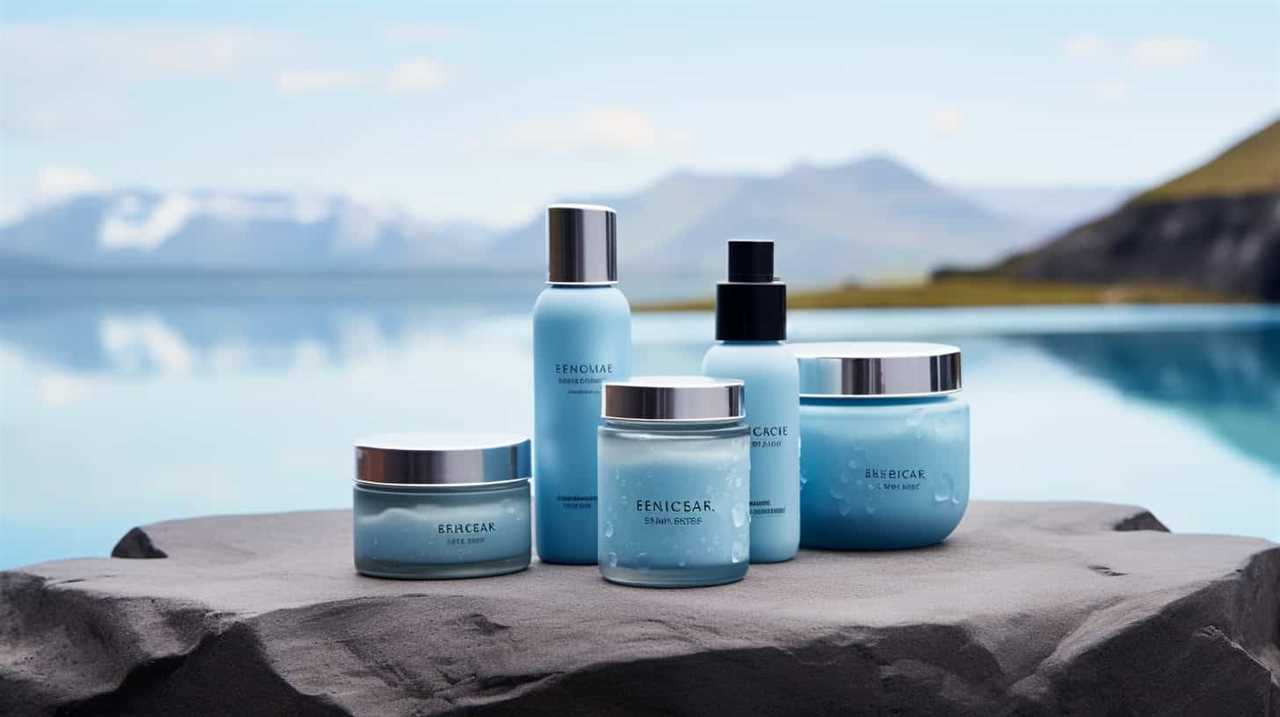
In addition to their emotional benefits, essential oils can also provide physical relief. For example, tea tree oil has antibacterial properties that can help treat acne and other skin conditions. Eucalyptus oil can help relieve congestion and improve respiratory function.
Indulge in a Soothing Bath: Tips for a Spa-like Experience
For an even more luxurious and indulgent spa-like experience, we can add a few drops of our favorite essential oils to the bathwater. The soothing aroma will envelop us as we relax in the warm embrace of the water. To enhance the experience further, we can consider using bubble bath or bath bombs. These delightful additions create a luxurious and effervescent atmosphere, transforming our bath into a true spa getaway. The gentle bubbles and fizzing sensation will uplift our senses and leave our skin feeling soft and rejuvenated. With a variety of scents and colors to choose from, we can customize our bath to suit our mood and preferences. Indulging in a soothing bath with the addition of essential oils, bubble bath, or bath bombs is an easy and affordable way to create a spa-like experience in the comfort of our own home.
| Bath Products | Benefits | Recommended Brands |
|---|---|---|
| Essential Oils | Relaxation, stress relief, aromatherapy | Young Living, doTERRA, Aura Cacia |
| Bubble Bath | Foaming, softening, moisturizing | Dr. Teal’s, Aveeno, L’Occitane |
| Bath Bombs | Fizzing, aromatherapy, moisturizing | Lush, Bath & Body Works, Da Bomb |
Unwind and De-stress: Incorporating Relaxation Techniques
We can incorporate various relaxation techniques to unwind and de-stress, creating a tranquil spa-like atmosphere in the comfort of our own home.
One effective technique is meditation, which promotes a sense of calm and relaxation. Find a quiet space, sit comfortably, and focus on your breath. Allow your thoughts to come and go without judgment.
Another way to de-stress is through stress relief exercises. Engaging in physical activity, such as yoga or tai chi, can help release tension and promote relaxation. These practices combine gentle movements with deep breathing, enhancing overall well-being.
Frequently Asked Questions
What Are Some Common Essential Oils Used in Aromatherapy and Their Benefits?
Some common essential oils used in aromatherapy and their benefits include lavender for relaxation, peppermint for headache relief, and eucalyptus for congestion. We can use these oils to create a spa-like atmosphere at home for ultimate relaxation.
How Long Should I Soak in the Bath to Get the Full Relaxation Benefits?
To maximize relaxation benefits, we recommend soaking in the bath for at least 20 minutes. This allows your muscles to fully relax and your mind to unwind. It’s the perfect way to create a spa experience at home.
Can I Use Regular Household Items to Create a Spa-Like Atmosphere at Home?
Yes, we can use regular household items to create a spa-like atmosphere at home. Using household items for DIY facials can provide numerous benefits, such as relaxation, rejuvenation, and a sense of well-being.
Are There Any Specific Facial Treatments That Are Recommended for Different Skin Types?
Different skin types require different facial treatments. It’s important to choose the right one for your skin’s needs. Some recommendations include exfoliation for dry skin and clay masks for oily skin. Essential oils like lavender and tea tree offer added benefits.
What Are Some Effective Relaxation Techniques That Can Be Easily Incorporated Into a Daily Routine?
Incorporating relaxation techniques into our daily routine is essential for finding inner peace and reducing stress. By taking time for activities like deep breathing, meditation, and gentle stretching, we can create a spa-like experience at home.
What Are the Essential Ingredients for Creating a Relaxing At-Home Spa?
Creating a relaxing at-home spa is easy with simple at-home spa treatments. Start by gathering essential oils like lavender or eucalyptus, soothing music, and fluffy towels. Invest in a quality robe and slippers for added comfort. Don’t forget to dim the lights and light a few candles for a tranquil ambiance.
Conclusion
In conclusion, creating a spa experience at home is a perfect way to relax and indulge in self-care.
While some may argue that it’s not the same as going to a professional spa, the truth is that with a little effort and creativity, you can create a soothing and rejuvenating atmosphere right in the comfort of your own home.

So why not treat yourself to a spa day without leaving the house? Your mind, body, and soul will thank you for it.
- About the Author
- Latest Posts
Introducing Charles, the Editor in Chief at ByRetreat, whose passion for interior design and editorial excellence elevates every remote workspace to new heights. With his keen eye for detail, impeccable taste, and expertise in design, Charles brings a wealth of knowledge and creativity to the ByRetreat team.
As the Editor in Chief of a renowned lifestyle blog, Charles has honed his skills in curating captivating content and staying up-to-date with the latest trends in interior design. His deep understanding of aesthetics and the power of storytelling through design enables him to create remote workspaces that are not only visually stunning but also rich in personality and meaning.
Retreat
Planning a Spiritual Retreat: Your Guide to Tranquility

Welcome to our extensive guide on planning a spiritual retreat. Our goal is to assist you in arranging a retreat that rejuvenates your mind, body, and spirit. Whether you’re looking for a spiritual getaway in the peaceful settings of Colorado or needing advice on organizing a retreat, we have everything you need. Explore valuable tips, inspirational ideas, and a useful retreat planning checklist to establish the ideal haven for your spiritual journey.
At Drala Mountain Center, we believe that a well-planned and intentional retreat can provide the tranquility and rejuvenation you seek. With serene forests and majestic mountains as our backdrop, Colorado sets the stage for a transformative retreat experience. Let’s embark on this sacred journey together, diving into the essentials of planning a soul-nurturing spiritual retreat.Key Takeaways:
- Plan a transformative spiritual retreat with our expert guide.
- Discover the serene landscapes of Colorado for your retreat.
- Explore a variety of retreat types to suit your preferences.
- Consider important factors when selecting the right retreat for you.
- Prepare yourself physically, mentally, and emotionally for a fulfilling retreat experience.
Why Choose Colorado for Your Yoga Retreat?
In Colorado, nature serves as more than just a scenic backdrop—it’s an active participant in your wellness journey. The state’s stunning natural elements contribute to a balanced and enriched yoga practice. For example, the purity of the mountain air can deepen your breathwork, making each inhalation a revitalizing experience. Moreover, the tranquility that pervades these settings fosters a deeper meditation experience. We proudly offer such holistic, nature-integrated experiences at our Drala Mountain Center retreats, situated in the most spiritually elevating locations throughout Colorado.
Put your body and mind in sync with nature on your spiritual retreat in Colorado.
| Benefits of Choosing Colorado for Your Yoga Retreat |
|---|
| 1. Serene Mountain Landscapes |
| 2. Fresh and Purity of Mountain Air |
| 3. Tranquil and Peaceful Settings |
| 4. Deepen Breathwork Practices |
| 5. Enhance Meditation Experience |
Types of Yoga Retreats in Colorado
Yoga is a versatile practice with numerous styles, each offering its own unique set of benefits. At Drala Mountain Center, we honor this diversity by offering a broad range of yoga retreats to suit every practitioner.
Retreats You Can Choose From:
- Adventure Yoga Retreats: These retreats combine traditional yoga practices with the thrill of outdoor adventures like hiking and kayaking. Perfect for those who seek both excitement and tranquility.
- Wellness Yoga Retreats: These retreats place a comprehensive focus on your overall well-being. In addition to yoga, expect activities like spa treatments, guided nutritional planning, and mindfulness practices.
- Spiritual Yoga Retreats: Ideal for those seeking a deeper spiritual connection, these retreats emphasize ancient yogic philosophies, meditation practices, and spiritual teachings along with traditional yoga asanas.
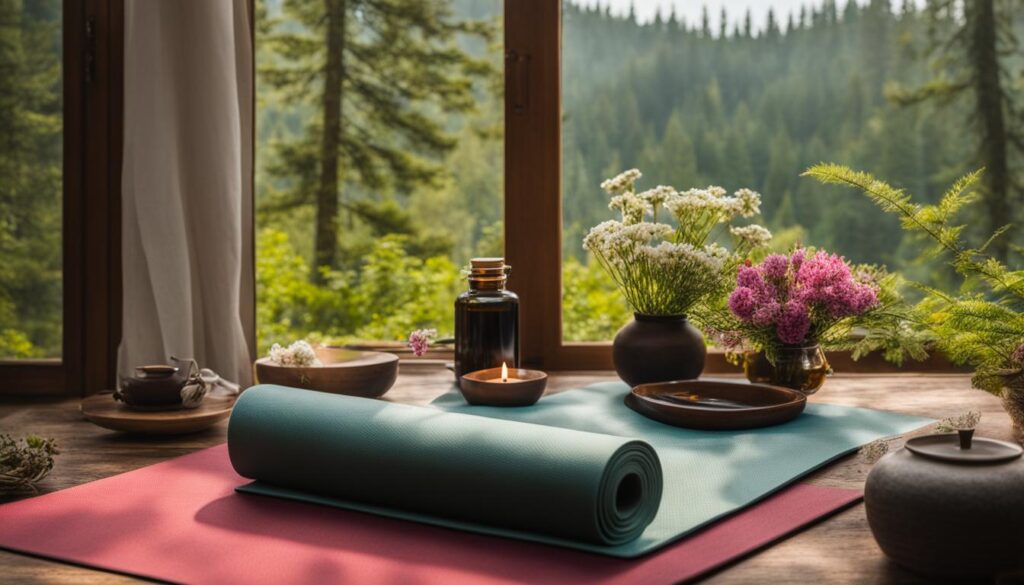
Packing Essentials for Your Yoga Retreat:
- Comfortable yoga attire
- Personal yoga mat, blocks, or straps
- Skincare products for varying weather conditions
Activities Beyond Yoga:
“Nature hikes, lakeside meditation sessions, cultural visits, and cooking classes are just a few examples of the activities that can enrich your yoga retreat experience.”
The Benefits of a Spiritual Retreat
The benefits of participating in a spiritual retreat are numerous and can have a profound impact on your overall well-being. Retreats provide an opportunity to disconnect from the chaos of everyday life and immerse yourself in a peaceful and nurturing environment. This can help reduce stress and anxiety, improve mental clarity, and promote emotional well-being. Retreats also offer a chance to deepen your spiritual practices and gain a deeper understanding of yourself and your path.
The mindful activities, such as yoga and meditation, can enhance physical fitness, flexibility, and overall health. Furthermore, retreats often provide a supportive community where you can connect with like-minded individuals and share experiences, leading to personal growth and lasting friendships.
The Mental and Physical Benefits of Retreats
1. Stress Reduction: Taking a break from your daily routine and immersing yourself in a retreat environment can significantly reduce stress levels. The serene and tranquil atmosphere allows you to relax, unwind, and focus on your well-being.
2. Mental Clarity: Retreats provide an opportunity to detach from distractions and gain mental clarity. Through practices like meditation and introspection, you can quiet your mind, release mental clutter, and gain a fresh perspective on life.
3. Emotional Well-being: Retreats offer a safe space for emotional healing and self-reflection. Engaging in activities that promote self-care and self-exploration can help you process emotions, release negative patterns, and cultivate a positive mindset.
“A retreat is like pressing the pause button on your life, giving you the opportunity to recharge, reflect, and reconnect with your true self.”
4. Physical Fitness: Retreats often incorporate physical activities like yoga, hiking, or other forms of exercise. These activities can improve physical fitness, increase flexibility, and contribute to a healthier lifestyle.
5. Spiritual Growth: Retreats create a nurturing environment for spiritual exploration and growth. Through practices like meditation, prayer, and guided spiritual teachings, you can deepen your connection with yourself, others, and the divine.
6. Community and Connection: Retreats foster a sense of community and belonging. By sharing experiences, engaging in group activities, and connecting with like-minded individuals, you can form meaningful connections and create lifelong friendships.
| Benefits of Spiritual Retreats | Spiritual Retreat Advantages |
|---|---|
| Reduced stress and anxiety | Opportunity for self-reflection |
| Improved mental clarity | Nurturing environment for emotional healing |
| Enhanced physical fitness and flexibility | Promotes spiritual growth and connection |
| Opportunity for personal growth | Forming lasting friendships and community |
Finding the Right Spiritual Retreat for You
Finding the perfect spiritual retreat can make all the difference in creating a fulfilling and transformative experience. At Drala Mountain Center, we understand the importance of selecting a retreat that aligns with your personal goals and interests. Here are some essential tips to help you find the retreat that resonates with you:
- Consider your personal goals and interests: Reflect on what you hope to achieve from a spiritual retreat. Are you seeking inner peace, self-discovery, or a deeper connection to your spiritual practice? Understanding your intentions will guide you towards a retreat that can fulfill your needs.
- Research different retreat centers: Take the time to explore various retreat centers and their offerings. Read reviews from past participants to gain insights into the atmosphere, teachings, and overall experience. Look for centers that resonate with your values and philosophy.
- Location and setting: Consider the environment in which you thrive. Are you drawn to the serene mountains, the soothing sounds of the ocean, or the calm of a secluded forest? The location and setting of the retreat play a significant role in creating a nurturing and transformative experience.
- Duration and budget: Determine the ideal duration for your retreat and ensure it fits into your schedule. Consider whether a weekend getaway or a longer retreat will better serve your goals. Additionally, carefully assess your budget and select a retreat that aligns with your financial situation.
- Trust your intuition: Ultimately, trust your instincts and choose a retreat that feels right for you. Listen to your inner voice and select a retreat center where you feel a strong connection. Following your intuition will ensure a meaningful and fulfilling experience.
Remember, finding the right spiritual retreat is a personal journey. By considering your goals, exploring different retreat centers, and trusting your intuition, you can embark on a transformative retreat that aligns with your aspirations. Take the time to choose a retreat that resonates with you, and prepare to embark on a profound and enriching spiritual journey.
Preparing for Your Spiritual Retreat
To fully immerse yourself in your spiritual retreat experience, it’s important to prepare yourself physically, mentally, and emotionally.
Start by clearing your schedule and informing loved ones about your retreat plans. This will allow you to fully disconnect and focus on your spiritual journey.
Pack essential items such as comfortable clothing, personal items, and any necessary spiritual tools.
*image*
It’s also beneficial to set intentions and goals for your retreat, whether it’s seeking clarity, relaxation, or self-discovery.
Lastly, approach your retreat with an open mind and heart, ready to embrace the transformative experience that awaits you.
| Preparation Tips for Your Spiritual Retreat | Benefits |
|---|---|
| Clear your schedule | Allows full immersion and focus on your journey |
| Inform loved ones | Ensures uninterrupted retreat experience |
| Pack essential items | Comfort and convenience during the retreat |
| Set intentions and goals | Focuses your retreat experience and personal growth |
| Approach with open mind and heart | Ready to embrace transformative experiences |
Nurturing Your Spirit During the Retreat
While on your retreat, prioritize nurturing your spirit and engaging in practices that promote personal growth and well-being. This is a precious time for self-reflection and introspection, where you can delve deeper into your inner world and explore the depths of your being. By taking the opportunity to disconnect from distractions and fully immerse yourself in the retreat experience, you create the space for transformative growth and inner peace to flourish.
Embrace a variety of spiritual practices during your retreat to deepen your connection with your inner self and the retreat community. Engage in daily yoga sessions, allowing the movements to flow with your breath and cultivate a sense of unity between your body, mind, and spirit. Explore the power of meditation, finding stillness within and discovering the peace that resides in the present moment. Attend communal gatherings to share insights, experiences, and collective wisdom, fostering a sense of belonging and connection.
Immerse yourself in the healing power of nature by taking silent walks in its embracing embrace. Allow the sounds of chirping birds, rustling leaves, and flowing water to synchronize with the rhythm of your breath, grounding you in the present moment. Observe the intricate beauty of the natural world around you, finding solace and inspiration in its harmonious existence.
Throughout your retreat, practice self-care to nourish your body, mind, and spirit. Feed your body with nutritious meals that energize and support your well-being. Prioritize rest and relaxation, allowing yourself time to recharge and rejuvenate. Engage in gentle physical activities such as stretching, walking, or swimming that honor your body’s needs and promote holistic wellness.
Remember to celebrate each moment of your retreat and fully embrace the transformative journey you are embarking on. Allow yourself to be fully present, savoring the experiences, revelations, and connections that arise. This is a time for personal transformation, inner growth, and deep spiritual nourishment.

Let your spirit soar amidst the serene beauty of your retreat surroundings. Surrender to the transformative power of this sacred space and trust that it will guide you on your path of self-discovery and inner peace.
Embracing the Transformative Power of a Spiritual Retreat
Spiritual retreats offer a unique opportunity for personal transformation and growth. At Drala Mountain Center, we believe in the profound impact that retreats can have on individuals seeking personal growth and spiritual awakening. By immersing yourself in a supportive and nurturing environment, you open yourself up to profound experiences and insights that can guide you on your spiritual journey.
During our retreats, we offer a variety of practices and teachings that are designed to help you embrace the transformative power of the retreat experience. Whether it’s through yoga, meditation, mindfulness practices, or communal gatherings, each aspect of the retreat is carefully curated to provide a holistic and immersive experience.
To fully embrace the transformative power of a spiritual retreat, it is essential to be open to new perspectives and ways of thinking. Challenging yourself to step outside of your comfort zone can lead to breakthroughs and personal growth. Trusting the process and surrendering to the transformative power of the retreat allows for deep self-reflection, healing, and spiritual awakening.
Embracing the Retreat Experience
During your time at Drala Mountain Center, we encourage you to embrace the retreat experience with openness and willingness. Engage fully in the practices and teachings offered, allowing them to guide you on your journey of self-discovery and inner transformation. Be present in each moment, immersing yourself in the beauty of nature and the wisdom of ancient spiritual traditions.
“The beauty of a spiritual retreat lies in its ability to create a sacred space where personal growth and spiritual awakening can flourish.” – Drala Mountain Center
Throughout the retreat, you may encounter challenges, both physical and emotional. It is through these challenges that true growth occurs. Embrace these moments as opportunities for self-discovery and breakthroughs. With the support of our experienced facilitators and the nurturing environment of Drala Mountain Center, you will emerge from your retreat with a deeper connection to your inner self and a renewed sense of purpose.
Transformative Benefits of Retreats
The transformative power of a spiritual retreat extends beyond the retreat itself. The insights and experiences gained during the retreat can have lasting effects on your everyday life. By embracing the retreat experience, you can achieve personal growth, spiritual awakening, and a deeper connection with your inner self, leading to a more fulfilling and purposeful life.
Here are some of the benefits you may experience by embracing the transformative power of a spiritual retreat:
- Enhanced self-awareness and self-discovery
- Increased clarity and focus
- Improved physical and mental well-being
- Greater resilience and ability to navigate life’s challenges
- Deeper connection with your spiritual path
- Strengthened relationships and enhanced communication skills
Testimonials from Previous Retreat Participants
| Participant Name | Retreat Experience |
|---|---|
| Emily Smith | “The retreat was a transformative experience that allowed me to reconnect with myself on a deep level. The practices and teachings offered at Drala Mountain Center have forever changed my life. I am eternally grateful.” |
| John Davis | “The spiritual retreat at Drala Mountain Center was a profound experience. It was a safe space for self-reflection, healing, and growth. I came back a changed person, with a renewed sense of purpose and a deeper connection with my spirituality.” |
These testimonials are just a glimpse into the transformative power of our retreats. Join us at Drala Mountain Center and experience the life-changing benefits of embracing the transformative power of a spiritual retreat.
The Lasting Impact of a Spiritual Retreat
The impact of a spiritual retreat extends far beyond the duration of the retreat itself. The insights, teachings, and experiences gained during the retreat can be integrated into your everyday life, bringing lasting positive changes.
After the retreat, take the time to reflect on your experiences and identify the lessons and practices that resonate with you. This self-reflection allows you to deepen your understanding and create a personal connection with the retreat’s teachings.
Once you have identified these valuable insights, it is essential to integrate them into your daily routine. Incorporate practices such as meditation, mindfulness, or other spiritual rituals into your everyday life. By doing so, you can carry the tranquility and serenity experienced during the retreat into your daily activities, maintaining a sense of calm and balance.
Staying connected with the retreat community and seeking ongoing support and guidance on your spiritual journey is also beneficial. Sharing your experiences, seeking advice, and participating in communal gatherings can provide a sense of belonging and nourishment for continued growth.
Remember that the impact of the retreat is not limited to the time spent at the retreat center. By nurturing the seeds planted during the retreat, you can cultivate a more peaceful, balanced, and fulfilling life.
| Benefits of Integrating Retreat Experiences | How to Integrate Retreat Experiences |
|---|---|
|
|
Conclusion
Planning a spiritual retreat is a deeply personal and transformative process. By following the steps outlined in this guide, you can embark on a journey of self-discovery, renewal, and inner peace. From choosing the right retreat to preparing yourself physically and mentally, each aspect plays a significant role in creating a meaningful retreat experience.
Remember to be present, embrace the practices and teachings offered, and nurture your spirit throughout the retreat. The benefits of a spiritual retreat can extend far beyond the duration of the retreat itself, positively impacting your overall well-being and enhancing your everyday life. So, take the first step towards planning your spiritual retreat and embark on a transformative journey of self-exploration and tranquility.
Whether you seek to deepen your yoga practice, reconnect with nature, or explore your spiritual path, a well-planned retreat can provide the space and guidance you need. Allow yourself to be immersed in a nurturing environment, surrounded by like-minded individuals, and led by experienced teachers. Trust in the power of retreats to inspire personal growth, ignite inner peace, and create lasting memories. Start your retreat planning journey today and open the door to a profound and fulfilling experience.
FAQ
How do I choose the right spiritual retreat?
Consider your personal goals and interests, research different retreat centers, read reviews, pay attention to the location and setting, and consider the duration and budget.
What should I bring to a spiritual retreat?
Comfortable yoga attire, personal yoga mats, blocks or straps (optional), special skincare products, and any specific items recommended by the retreat center.
What other activities can I engage in during a spiritual retreat in Colorado?
You can participate in nature hikes, lakeside meditation sessions, cultural visits, cooking classes, and other activities offered by the retreat center.
What are the benefits of participating in a spiritual retreat?
Retreats provide an opportunity to reduce stress, improve mental clarity, promote emotional well-being, deepen spiritual practices, enhance physical fitness, and connect with like-minded individuals.
How do I find the right spiritual retreat for me?
Consider your personal goals and interests, research different retreat centers, read reviews, and choose a retreat that aligns with your preferences.
How should I prepare for a spiritual retreat?
Clear your schedule, inform loved ones, pack essential items, set intentions and goals, and approach the retreat with an open mind and heart.
How can I nurture my spirit during the retreat?
Engage in self-reflection, meditation, journaling, silent walks in nature, spiritual practices, and self-care activities.
How can I embrace the transformative power of a spiritual retreat?
Embrace the practices and teachings offered, be open to new perspectives, trust the process, and surrender to the transformative experience.
What is the lasting impact of a spiritual retreat?
The insights, teachings, and experiences gained can be integrated into daily life, bringing lasting positive changes, personal growth, and a more balanced and fulfilling life.
- About the Author
- Latest Posts
Meet Bethia, the visionary designer at ByRetreat who brings a touch of magic to every remote workspace she creates. With a boundless imagination and an eye for beauty, Bethia is passionate about transforming ordinary spaces into extraordinary havens of creativity and comfort.
Bethia possesses a unique talent for envisioning the perfect combination of furniture, colors, and textures that harmonize seamlessly in a room. She understands that selecting furniture goes beyond mere functionality; it’s about curating pieces that evoke a sense of style and sophistication while enhancing the overall ambiance.
Spa Design
10 Spa Design and Architecture Ideas for a Relaxing Retreat
From serene nature-inspired sanctuaries to cutting-edge technological innovations, discover how spa design transcends relaxation to redefine the art of tranquility.

As we explore the realm of spa design and architecture for a tranquil escape, we uncover a realm of innovative concepts that redefine relaxation spaces.
From the subtle interplay of elements to the strategic utilization of light and color, each idea is meticulously crafted to elevate the sensory experience of guests.
By seamlessly blending nature, technology, and sustainable practices, designers have crafted environments that aim to transport visitors to a realm of serenity and rejuvenation.
Join us on this journey where every detail is meticulously considered to create a harmonious sanctuary for the mind and body.
Key Takeaways
- Incorporate natural elements like wood and plants for a serene ambiance.
- Utilize tranquil water features such as pools and waterfalls for relaxation.
- Create cozy lighting with soft glows and natural light for a calming atmosphere.
- Embrace Zen-inspired minimalism with clean lines and uncluttered spaces for serenity.
Natural Elements and Greenery
Immersing ourselves in the lush embrace of natural elements and vibrant greenery within spa spaces elevates our senses and transports us to a realm of unparalleled tranquility and rejuvenation. The strategic incorporation of natural materials like wood, stones, and living plants not only enhances the aesthetic appeal of the spa but also plays a vital role in promoting well-being. By embracing biophilic design principles, spas create a harmonious environment that fosters a deep connection with nature.
Greenery in spa architecture serves a dual purpose, not only adding beauty but also purifying the air and reducing stress levels for guests. Indoor waterfalls and living plant walls not only create a visually stunning backdrop but also contribute to a sense of calm and relaxation. The use of sustainable materials not only grounds visitors but also minimizes indoor pollution, ensuring a holistic and rejuvenating spa experience. By incorporating outdoor spaces like gardens or balconies, spas provide guests with the opportunity to further immerse themselves in the natural environment, enhancing their overall relaxation and well-being.
Tranquil Water Features
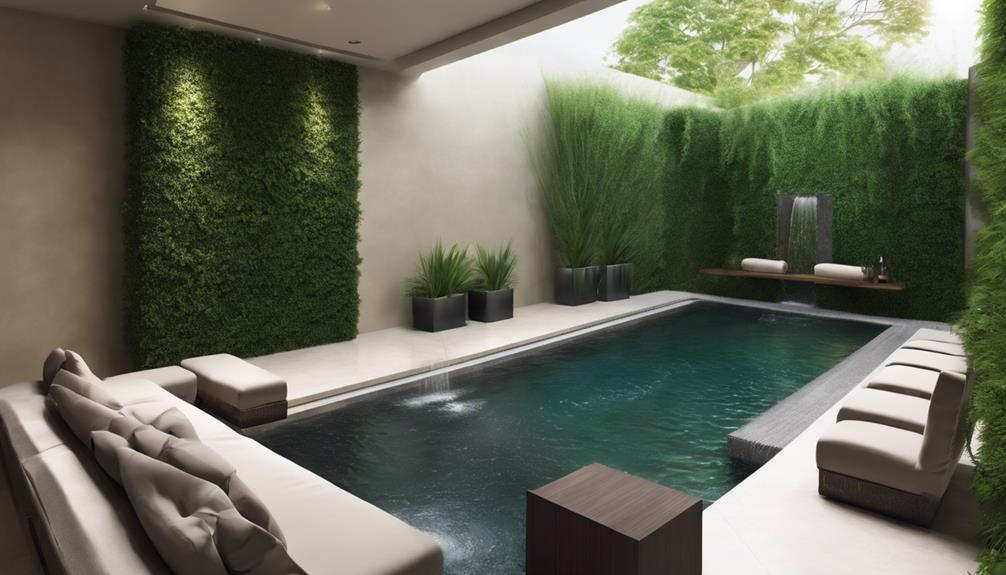
Incorporating tranquil water features into spa design not only enhances the ambiance but also fosters relaxation, stress reduction, and a deep connection to nature. Water features like indoor pools, waterfalls, and reflecting ponds are essential elements in creating a serene spa environment. These features, such as infinity pools or hydrotherapy tubs, offer therapeutic benefits that elevate the overall spa experience. The soothing sound and sight of flowing water can have a calming effect on the mind, helping to reduce anxiety and induce a sense of peace.
Here is a table showcasing the variety of tranquil water features commonly found in spa designs:
| Water Feature | Description | Benefits |
|---|---|---|
| Indoor Pools | Enclosed water bodies for relaxation | Promotes physical and mental well-being |
| Waterfalls | Cascading water elements for tranquility | Creates a soothing ambiance |
| Reflecting Ponds | Still waters reflecting the surroundings | Enhances visual appeal |
Customizing water features to match the spa's aesthetic can add a touch of luxury and tranquility, making the spa a true retreat for relaxation and rejuvenation.
Cozy and Relaxing Lighting
Let's bask in the gentle glow of soft lighting that can instantly set a cozy and soothing atmosphere in our spa spaces.
With dimmable options at our fingertips, we can easily adjust the brightness to cater to various moods and preferences.
Soft Glow Ambiance
Creating a soft glow ambiance through carefully selected lighting fixtures is essential in spa design to evoke a cozy and relaxing atmosphere for guests. Incorporating natural light along with soft glows in spa architecture enhances the overall wellness experience, providing a tranquil retreat for relaxation. To achieve this serene ambiance, a combination of dimmable lights, ambient fixtures, and soft lighting sources like wall sconces, pendant lights, and recessed lighting can be strategically placed. Candlelight and indirect lighting further contribute to a calming environment, inviting guests to unwind and de-stress. By blending these elements, spa spaces can offer a soothing haven where individuals can escape the hustle and bustle of everyday life.
| Lighting Fixtures | Description | Effect |
|---|---|---|
| Wall Sconces | Soft, indirect light | Creates a warm ambiance |
| Pendant Lights | Gentle illumination | Adds a touch of elegance |
| Recessed Lighting | Subtle glow | Enhances relaxation |
Dimmable Lights Options
To achieve an inviting and tranquil ambiance in spa spaces, exploring dimmable lights options is key to creating a cozy and relaxing atmosphere for guests. Dimmable lights offer adjustable brightness levels that can be customized to cater to different moods and activities, enhancing the overall wellness experience.
These lighting options help set the right atmosphere for relaxation, meditation, or rejuvenation during spa treatments, contributing to a soothing environment that promotes stress reduction and tranquility for guests. By controlling the intensity of light, dimmable lights allow for a personalized and calming retreat in spa settings, making them an essential element in modern spa interior design.
Choosing the right dimmable lights can transform a spa into a sanctuary of comfort and relaxation.
Zen-Inspired Minimalism
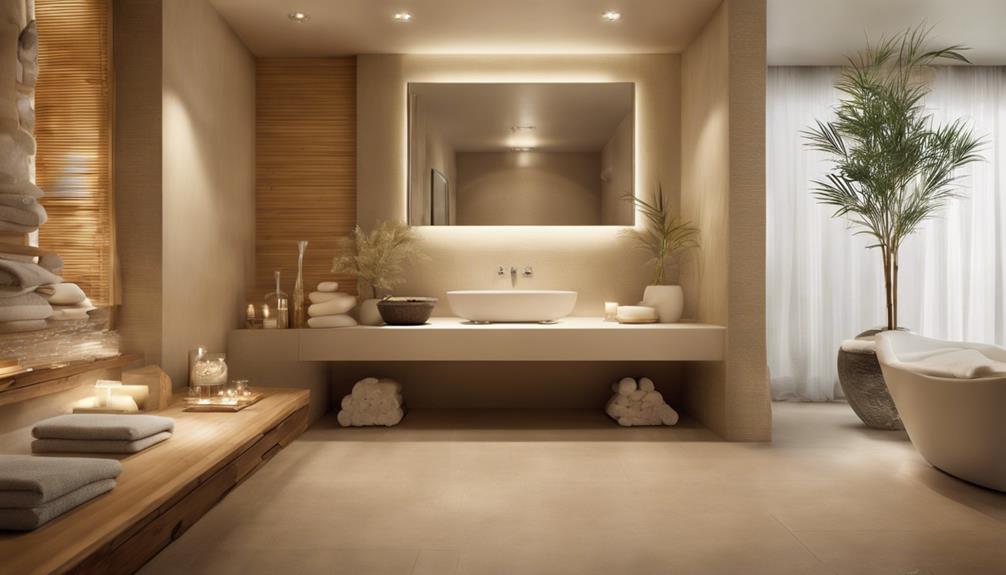
Immersing ourselves in the essence of Zen-inspired minimalism within spa design transports visitors to a realm of simplicity, tranquility, and mindfulness.
In this architectural and design approach, natural balance is a key element, achieved through the use of materials like wood, stone, and bamboo. These natural elements create a harmonious and calming atmosphere, promoting a sense of peace and relaxation.
Clean lines, neutral colors, and uncluttered spaces are hallmarks of Zen-inspired minimalism, fostering mental clarity and a serene ambiance.
Integrating nature into the design, such as indoor plants and maximizing natural light, further enhances the Zen experience, connecting guests with the outdoors and creating a seamless transition between the spa environment and the natural world.
Minimalist furniture, characterized by low seating and simple decor, encourages a feeling of serenity and balance, completing the holistic approach to relaxation and well-being.
Harmonious Color Palettes
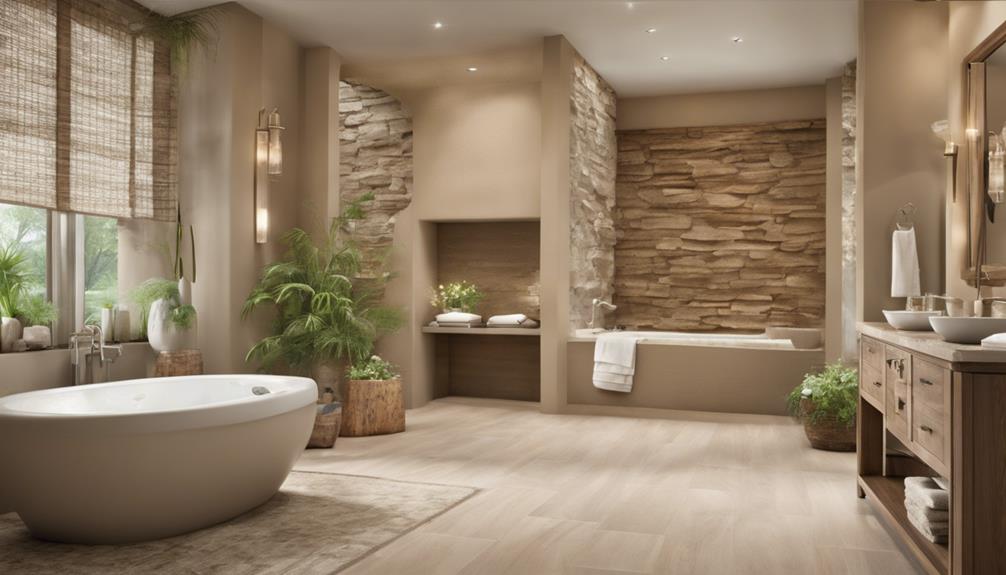
Warm neutrals like beige, gray tones, and earthy browns are foundational in creating a calming and grounded atmosphere in spa design. These hues form the base of a harmonious color palette, setting the tone for relaxation and tranquility.
To enhance this natural ambiance, consider these elements:
- Soft pastel colors such as pale blues, greens, and lavender can evoke a sense of serenity and peace.
- Natural elements like wood accents, stone features, and plant life seamlessly blend with harmonious color palettes, enriching the soothing environment.
- Contrasting colors like soft whites and deep blues add a touch of balance and visual interest to spa interiors, contributing to an overall harmonious design scheme.
- Incorporating natural light through large windows or skylights amplifies the effects of harmonious color palettes, promoting wellness and creating a serene ambiance.
- Introducing subtle pops of color through accents like artwork or cushions can add depth and character to the spa space, elevating the overall aesthetic.
Serene Outdoor Spaces
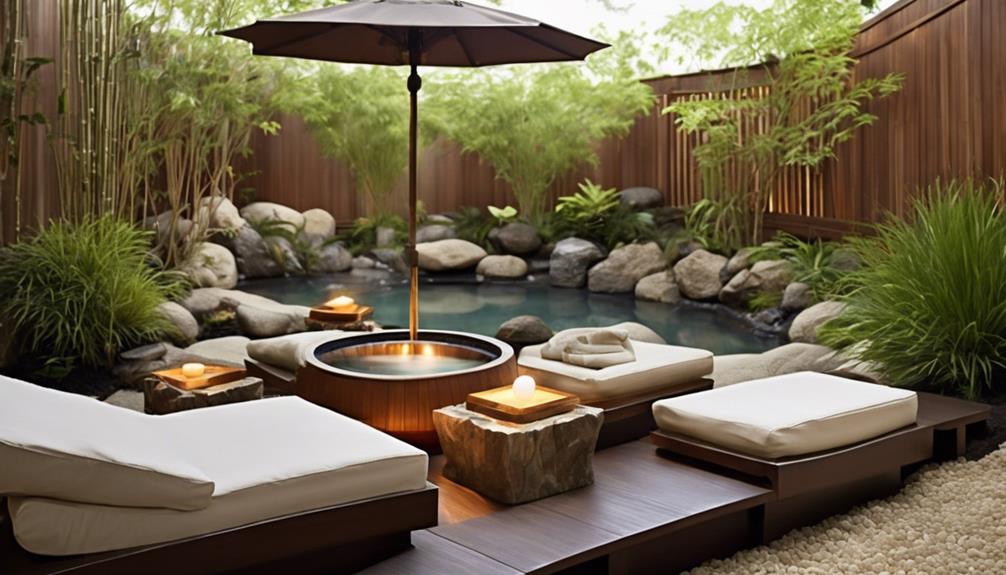
As we step into the realm of serene outdoor spaces in spa design, we find ourselves surrounded by the gentle rustle of leaves and the soothing melody of water features.
Integrating natural landscapes with tranquil water elements creates a harmonious oasis where guests can truly unwind amidst the beauty of nature.
It's a serene sanctuary where the stresses of the day melt away, inviting us to embrace the tranquility that only the outdoors can provide.
Natural Landscapes Integration
Nestled within our spa's design are lush gardens, cascading water features, and breathtaking vistas, seamlessly blending natural landscapes to create an oasis of tranquility and rejuvenation. Imagine the following elements enhancing your wellness journey:
- Greenery: Flourishing gardens with a variety of plants offer a sense of peace and harmony.
- Rocks: Strategically placed natural rocks provide a grounding effect, adding a touch of serenity.
- Natural Light: Sunlight filtering through trees creates a play of shadows, fostering a calming ambiance.
- Trees and Flowers: Vibrant blooms and tall trees sway gently in the breeze, connecting guests with nature.
- Open Skies: Expansive views of the sky allow guests to feel a sense of freedom and openness, enhancing the overall relaxation experience.
Tranquil Water Features
Embracing the essence of tranquility and natural serenity, our spa's design gracefully incorporates tranquil water features, inviting guests to immerse themselves in a harmonious outdoor oasis. The integration of reflective pools, cascading waterfalls, and serene ponds creates a peaceful ambiance that promotes relaxation and stress reduction. These water elements, a cornerstone of wellness architecture, connect guests to nature and enhance the overall sensory experience. Imagine the soothing sound of gently flowing water from fountains or streams enveloping you as you unwind in our outdoor spa spaces. These well-designed water features evoke a sense of tranquility, serenity, and rejuvenation, providing the ultimate escape for those seeking a holistic wellness retreat.
| Tranquil Water Features | Benefits |
|---|---|
| Reflective Pools | Promote relaxation |
| Cascading Waterfalls | Enhance sensory experience |
| Serene Ponds | Connect to nature |
| Gently Flowing Fountains | Create calming atmosphere |
| Rejuvenating Streams | Evoke sense of tranquility |
Healing Thermal Experiences
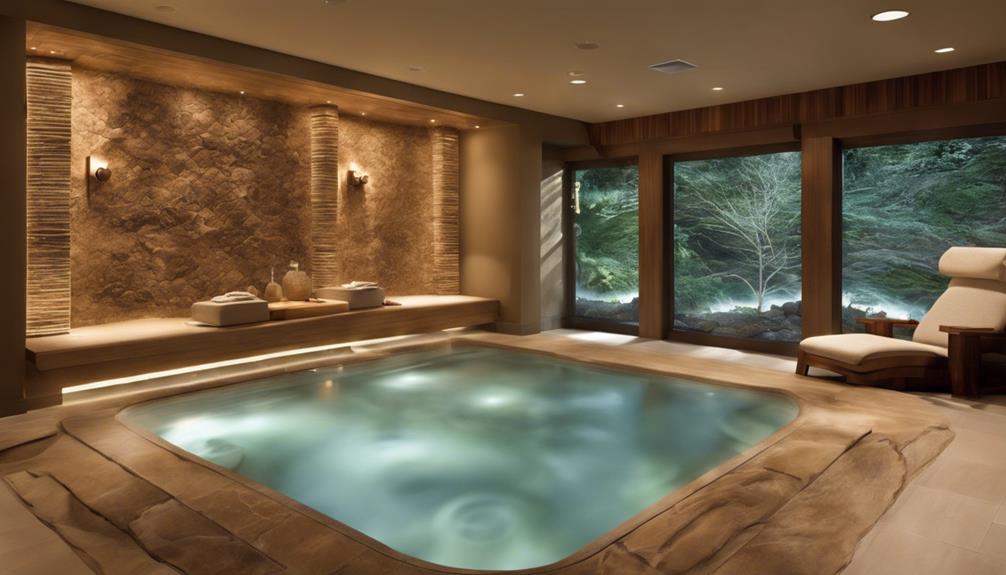
Amidst the serene ambiance of a spa, one can immerse themselves in healing thermal experiences that harness the therapeutic benefits of natural thermal waters. These experiences not only promote relaxation but also aid in detoxification and improved circulation.
Here are some common features you might find in spa designs that offer these healing thermal experiences:
- Thermal Pools: Imagine soaking in a warm, mineral-rich pool, letting the water soothe your muscles and calm your mind.
- Saunas: Step into a sauna and feel the dry heat envelop you, helping to release toxins and melt away tension.
- Steam Rooms: Enter a steam room where the moist heat opens your pores, promoting a deep detox and leaving your skin glowing.
- Hot/Cold Plunge Pools: Dip into a hot plunge pool to relax your muscles, then plunge into a cold pool for an invigorating contrast that boosts circulation.
- Ancient Bathing Traditions: These thermal experiences draw inspiration from ancient bathing rituals, combining the wisdom of the past with modern wellness practices.
Innovative Relaxation Pods
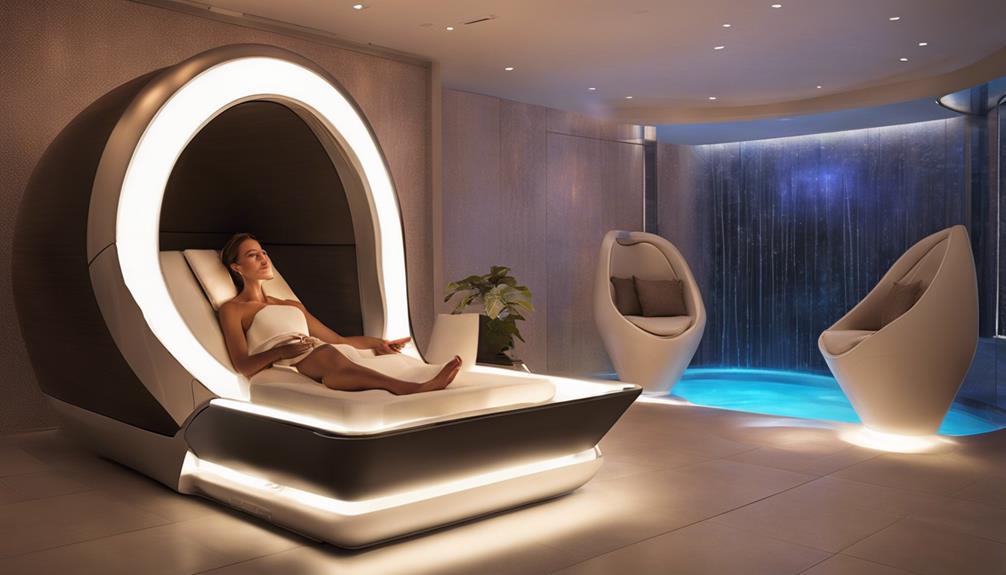
Drawing inspiration from the cocoon-like comfort of healing thermal experiences, innovative relaxation pods offer a modern sanctuary for individuals seeking to unwind and rejuvenate in a private setting. These private spas are meticulously designed to create a tranquil atmosphere, providing guests with a retreat from the hustle and bustle of daily life.
The design of these relaxation pods focuses on enhancing the overall sensory experience. Comfortable seating, soothing lighting, and calming decor elements are carefully curated to promote relaxation. Innovative features such as sound therapy, aromatherapy, and customizable settings cater to individual preferences, ensuring a personalized and immersive journey towards relaxation.
Moreover, some relaxation pods go beyond the traditional offerings by incorporating advanced technologies like integrated massage chairs and immersive audiovisual systems. These technological enhancements elevate the spa experience, enveloping guests in a world of serenity and bliss. Within spa environments, these pods serve as secluded oases, fostering tranquility and stress relief for those in need of a rejuvenating escape.
Sustainable and Eco-Friendly Design

Sustainable spa design integrates natural elements like plants, water features, and wood to establish a serene and eco-friendly atmosphere conducive to relaxation and rejuvenation. Imagine stepping into a subterranean spa oasis, where eco-conscious choices harmonize with luxury:
- Reclaimed Wood Accents: Rich textures and earthy tones of reclaimed wood adorn the treatment rooms, creating a warm and inviting ambiance.
- Bamboo Fixtures: Smooth bamboo fixtures add a touch of natural elegance to the space, embodying sustainability with style.
- Recycled Glass Details: Delicate recycled glass details sparkle throughout, reflecting light and adding a modern eco-friendly touch.
- Energy-Efficient Lighting: Soft, energy-efficient lighting gently illuminates the spa, enhancing the tranquil atmosphere while conserving energy.
- Water Conservation Innovations: From low-flow fixtures to innovative rainwater harvesting systems, every drop is cherished in this eco-conscious sanctuary.
In this sustainable haven, every detail is thoughtfully crafted to provide a guilt-free escape into relaxation.
Integrating Technology for Wellness
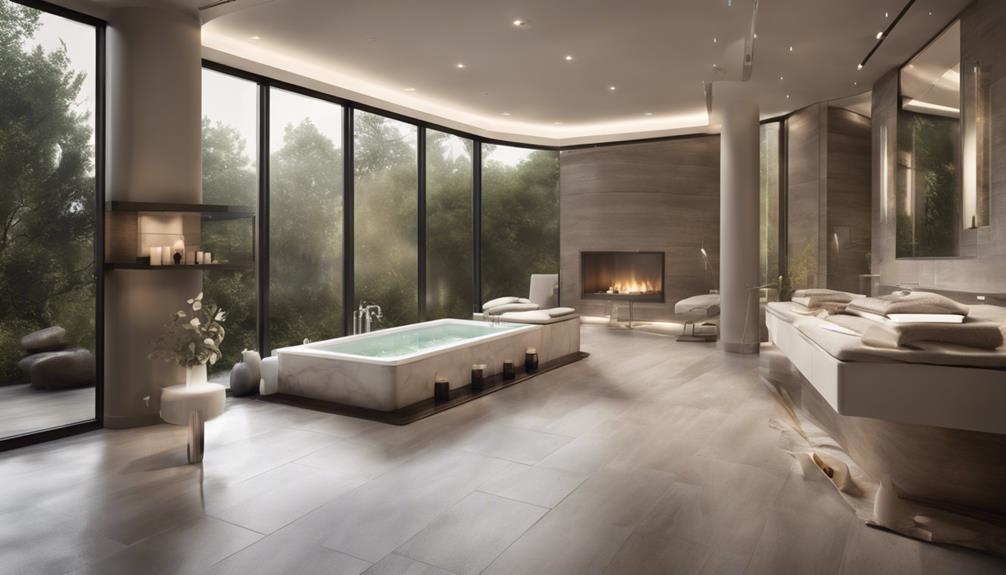
Let's explore how technology is revolutionizes the wellness experience in spas.
From circadian lighting systems that promote better sleep to LED lighting mimicking natural light for a tranquil ambiance, the integration of tech elevates relaxation.
Advanced features like soundscapes and aromatherapy systems engage all the senses, creating personalized and immersive spa journeys.
Tech for Relaxation
Incorporating cutting-edge technology into spa environments enhances relaxation and elevates the wellness experience for guests. When it comes to tech for relaxation, consider these innovative ideas:
- Circadian Lighting Systems: Regulate sleep-wake cycles with lighting that mimics natural light patterns.
- Wellness-Focused LED Lighting: Create a soothing ambiance with LED options replicating natural light.
- Multi-Sensory Experiences: Enhance emotional well-being with aromatherapy, soundscapes, and tactile materials.
- Calming Color Palettes: Use warm neutrals, gray tones, browns, and beiges for a sense of calm.
- Adaptable Spa Spaces: Optimize efficiency and guest satisfaction with flexible layouts and multi-functional areas.
Digital Wellness Tools
Embracing the synergy of technology and wellness, spa design now integrates digital wellness tools to revolutionize the guest experience. In our network of architecture, indoor environments are enhanced with cutting-edge solutions like mobile apps, wearable devices, and virtual reality experiences. These tools not only track biometric data and offer personalized wellness programs but also provide immersive relaxation experiences. Through remote consultations, real-time feedback, and interactive wellness encounters, guests can enjoy tailor-made treatments based on their stress levels, sleep patterns, and fitness progress. By leveraging digital wellness tools, spas can deliver a high-tech, personalized, and holistic approach to enhancing guests' well-being. Check out the table below to see the key features of these innovative tools:
| Digital Wellness Tools | Features |
|---|---|
| Mobile Apps | Biometric Data Tracking, Personalized Programs |
| Wearable Devices | Fitness Progress Monitoring, Stress Level Analysis |
| Virtual Reality Experiences | Immersive Relaxation Experiences, Interactive Wellness Encounters |
Frequently Asked Questions
How Do I Design My Spa Room?
Designing our spa room involves creativity and attention to detail. We incorporate calming colors, natural materials, adjustable lighting, and comfortable seating. Elements of nature like plants and water features enhance tranquility. Our goal is to create a personalized, relaxing retreat.
How Do I Turn My House Into a Spa Retreat?
We transform our home into a serene spa retreat by incorporating calming colors, biophilic elements, and sensory experiences. Adaptable spaces cater to various wellness activities. Circadian lighting ensures well-being. Our sanctuary fosters relaxation, bringing nature's essence indoors.
What Is the Wellness Center Design Concept?
We prioritize creating spaces that promote relaxation, rejuvenation, and overall well-being by integrating elements like biophilic decor and circadian lighting. Our designs cater to various wellness activities with adaptable layouts, calming colors, and sustainable materials.
What Is the Design Philosophy of Wellness?
Wellness design philosophy centers on creating spaces that enhance well-being holistically. We prioritize elements like natural light, biophilic decor, and circadian lighting for relaxation. Sustainability, adaptability, and functionality are key tenets.
Conclusion
As we conclude our exploration of spa design and architecture ideas for a relaxing retreat, we're reminded that creating a tranquil oasis is like painting a masterpiece – each element carefully chosen and intricately woven together to evoke a sense of harmony and serenity.
By incorporating natural elements, soothing water features, and sustainable design practices, architects have the power to transform spaces into sanctuaries where guests can truly unwind and rejuvenate.
- About the Author
- Latest Posts
Introducing Ron, the home decor aficionado at ByRetreat, whose passion for creating beautiful and inviting spaces is at the heart of his work. With his deep knowledge of home decor and his innate sense of style, Ron brings a wealth of expertise and a keen eye for detail to the ByRetreat team.
Ron’s love for home decor goes beyond aesthetics; he understands that our surroundings play a significant role in our overall well-being and productivity. With this in mind, Ron is dedicated to transforming remote workspaces into havens of comfort, functionality, and beauty.
Spa Design
7 Inspiring Spa Floor Plans for Your Design
Fascinating spa floor plans await, offering a glimpse into the transformative world of spa design.
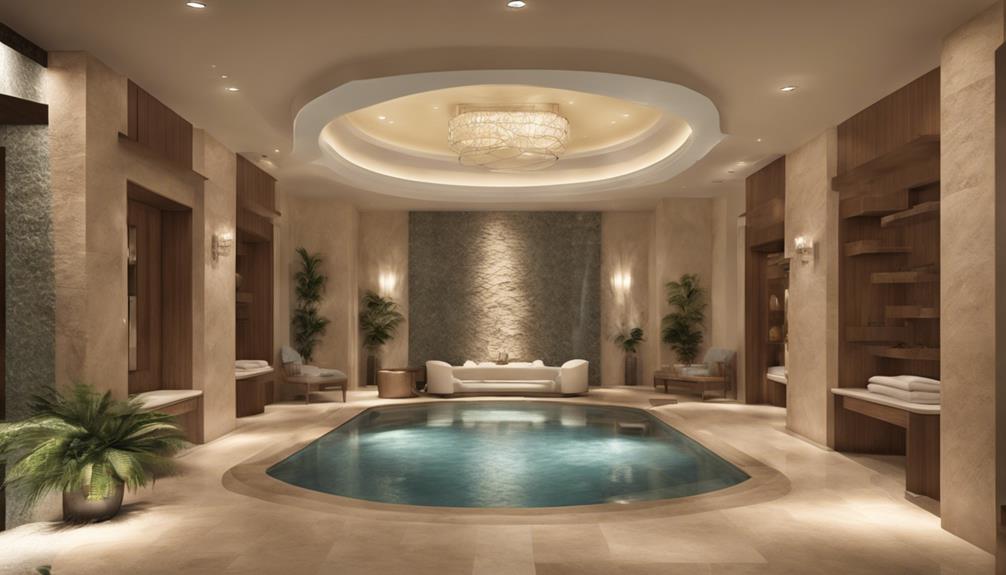
As we explore spa design, did you know that the layout and ambiance of a spa can impact a client's overall experience, influencing their likelihood to return?
When considering the design of a spa, floor plans play a crucial role in creating a harmonious space that caters to both functionality and relaxation. From intimate boutique layouts to expansive resort designs, each spa floor plan holds its unique charm and potential.
Let's uncover seven inspiring spa floor plans that could transform your design vision into a reality.
Key Takeaways
- Spa floor plans impact client experience through layout and ambiance.
- Zen-inspired elements like natural materials and soft colors enhance relaxation.
- Sustainable materials like bamboo and recycled glass promote eco-friendliness.
- Technology integration solutions optimize efficiency and personalize client experience.
Cozy Boutique Spa Layout
In crafting our cozy boutique spa layout, we infuse every corner with an intimate charm that beckons guests into a world of tranquility and personalized pampering. The salon interior design of our luxury spa exudes sophistication and comfort, offering a sanctuary where clients can unwind and rejuvenate. Soft, plush furnishings invite relaxation, while soothing colors and elegant decor create a sense of serenity throughout the space.
Our salon interior design focuses on creating a welcoming atmosphere, with carefully curated lighting to enhance the ambiance. The layout of our cozy boutique spa includes a stylish reception area that sets the tone for the entire experience. Treatment rooms are designed for maximum comfort and privacy, allowing guests to indulge in luxurious spa services with peace of mind.
Every detail in our luxury spa is thoughtfully considered to ensure a seamless and indulgent experience for our clients. From the calming relaxation spaces to the curated retail section offering premium products, our cozy boutique spa layout is designed to exceed expectations and provide a truly unforgettable pampering experience.
Modern Wellness Center Design
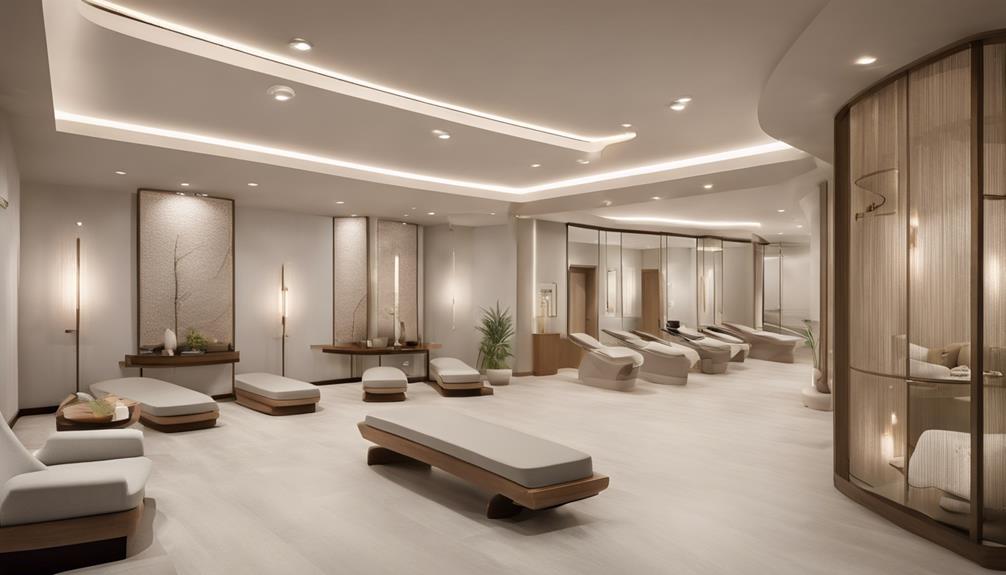
Let's explore the essence of modern wellness center design, where Zen-inspired elements, sustainable materials, and cutting-edge technology converge to create a harmonious space for rejuvenation.
By seamlessly blending natural textures like wood and stone with innovative technology solutions, these centers offer a sanctuary that promotes both physical and mental well-being.
Embracing a mindful approach to design, these spaces prioritize sustainability and holistic wellness experiences for all who seek balance and tranquility.
Zen-Inspired Design Elements
Elevating the ambiance of a modern wellness center design, Zen-inspired elements infuse tranquility and harmony into spa floor plans through the strategic use of natural materials and minimalist decor.
Incorporating bamboo, wood, and stone in the floor plan design evokes a sense of calm. Soft, neutral tones and simple decor contribute to the Zen aesthetic, fostering relaxation and mindfulness.
Indoor plants and water features strategically placed enhance the connection to nature, promoting harmony. Soft lighting, gentle curves, and open spaces encourage flow and peacefulness, creating a serene atmosphere.
These elements work together to craft a beauty salon environment that embodies the principles of Zen design, offering clients a space of rejuvenation and inner peace.
Sustainable Materials Selection
Infusing sustainability into the design ethos of a modern wellness center, our focus now shifts towards the meticulous selection of eco-conscious materials that harmonize with the environment and promote a healthier indoor experience. When designing the spa, we prioritize materials like bamboo for flooring and furniture due to its rapid growth and renewability. Recycled glass countertops and tiles not only offer a stylish touch but also reduce waste in landfills, aligning with our eco-friendly principles. Opting for low-VOC paints further enhances the indoor air quality by emitting fewer harmful compounds, contributing to an overall wellness-centered environment. Careful consideration of these sustainable materials ensures that our wellness center not only looks beautiful but also supports a healthier lifestyle.
| Eco-Friendly Material | Benefits | Usage |
|---|---|---|
| Bamboo | Rapid growth and renewability | Flooring and furniture |
| Recycled Glass | Stylish design element, waste reduction | Countertops and tiles |
| Low-VOC Paints | Improved indoor air quality | Walls and surfaces |
Technology Integration Solutions
Integrating cutting-edge technology seamlessly into our modern wellness center design enhances both the customer experience and operational efficiency. By incorporating advanced solutions such as automated booking systems and digital check-ins, we can streamline our spa services, optimize workflow, and reduce wait times.
Smart devices and interactive displays personalize services, engaging clients throughout their spa visit. This high-tech integration creates a seamless environment that caters to tech-savvy customers, meeting their expectations for a modern and innovative experience.
Embracing technology in our spa floor plans not only improves efficiency but also adds a touch of sophistication to the overall ambiance, setting us apart in the realm of wellness centers.
Zen Garden Spa Blueprint
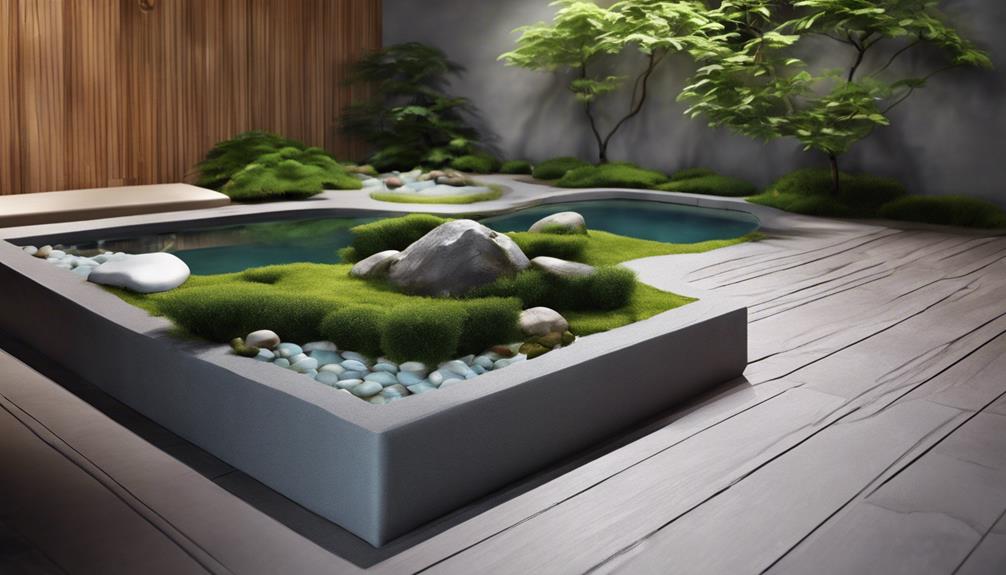
How can the Zen Garden Spa blueprint capture the essence of tranquility through its design elements? The Zen Garden Spa blueprint achieves a harmonious blend of nature and relaxation to provide guests with a serene experience. Here are some key elements that make this blueprint stand out:
- Japanese Garden Inspiration: Drawing inspiration from traditional Japanese gardens, the blueprint incorporates elements like bamboo, rocks, water features, and lush greenery to create a calming and peaceful ambiance.
- Distinct Zones: The layout includes separate zones for massage rooms, relaxation areas, meditation spaces, and a tea ceremony corner, allowing guests to immerse themselves fully in the spa experience.
- Natural Materials: By using materials like wood, stone, and paper screens, the spa enhances the Zen aesthetic and creates a connection to the natural world, promoting a sense of grounding and peace.
- Flow and Balance: The blueprint focuses on creating a harmonious flow and balance in the design, ensuring that every aspect contributes to the overall sense of wellness and relaxation for guests.
Luxury Resort Spa Floor Plan

Let's envision a luxury resort spa floor plan where every detail is meticulously planned to offer guests a truly indulgent experience.
From the layout of spa rooms to the strategic placement of amenities, every aspect is designed to create a seamless and serene environment.
The careful consideration of spaces like private relaxation rooms and specialized areas ensures that guests feel pampered and rejuvenated from the moment they step in.
Spa Room Layout
Within the layout of a luxury resort spa floor plan, the spa room design intricately weaves together elements of tranquility and sophistication to provide a truly indulgent experience for guests. As we delve into the world of spa room layouts in luxury resorts, here are some key points to consider:
- Treatment rooms are strategically positioned for privacy and optimal flow.
- The design focuses on creating a serene and upscale environment for guests to unwind.
- Amenities like saunas, steam rooms, and relaxation lounges are integrated to enhance the overall spa experience.
- Attention to detail in lighting, color schemes, and furniture placement contributes to the luxurious ambiance of the spa.
Each element plays a crucial role in shaping the overall experience, ensuring guests feel pampered and rejuvenated in this oasis of relaxation.
Amenities Placement
In crafting the luxury resort spa floor plan, the strategic placement of amenities such as saunas, steam rooms, and relaxation areas is meticulously orchestrated to ensure a harmonious flow for guests seeking a rejuvenating experience. Each amenity is thoughtfully positioned to enhance customer comfort and convenience, allowing for a seamless spa journey.
By strategically locating these features, guests can easily access various services, fostering a tranquil and revitalizing atmosphere. The design aims to create a symbiotic relationship between amenities, promoting a holistic and opulent spa experience.
Through careful consideration of placement, the luxury resort spa not only optimizes functionality but also elevates the overall ambiance, catering to the desires of discerning guests seeking innovation in their wellness retreats.
Urban Oasis Spa Spatial Concept
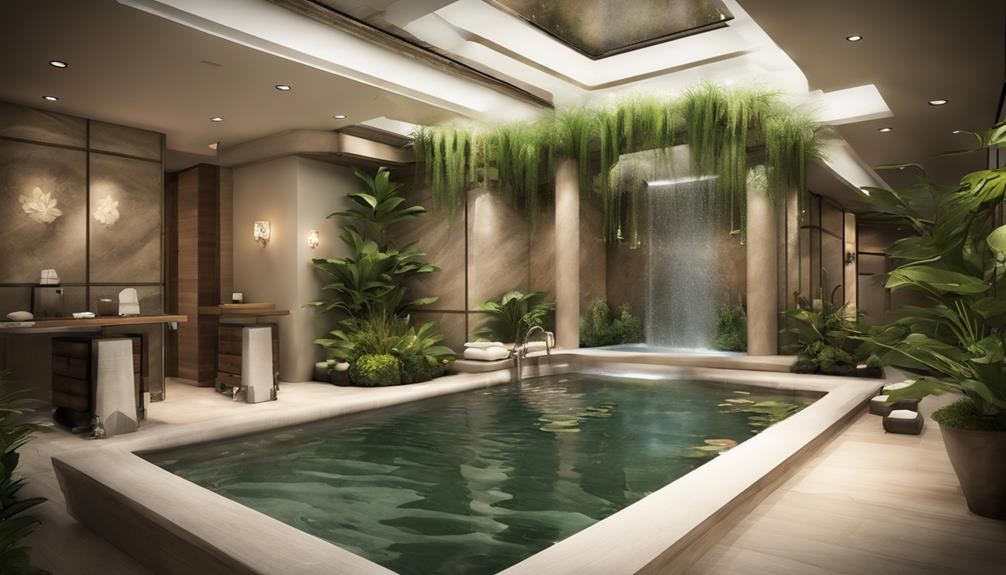
Amidst the urban hustle and bustle, the Urban Oasis Spa spatial concept emerges as a tranquil haven designed to immerse visitors in a serene retreat. This innovative design approach combines elements that transport guests from the city chaos into a peaceful sanctuary.
- Natural Elements: Water features, lush greenery, and earthy materials infuse the spa with a calming ambiance, creating a harmonious connection with nature.
- Strategic Layout: Carefully positioned treatment rooms, relaxation areas, and circulation spaces optimize the flow of the spa, ensuring a seamless and relaxing experience for visitors.
- Enhanced Ambiance: The floor plan maximizes natural light to flood the space, offering serene views of the urban landscape that further enhance the tranquil atmosphere.
- Thoughtful Integration: Functional zones such as reception, treatment rooms, relaxation areas, and changing facilities are seamlessly woven into the layout, promoting convenience and a sense of cohesion throughout the spa.
This spatial concept redefines urban wellness by blending contemporary design with elements of nature, creating an oasis of tranquility in the heart of the city.
Minimalist Spa Retreat Arrangement
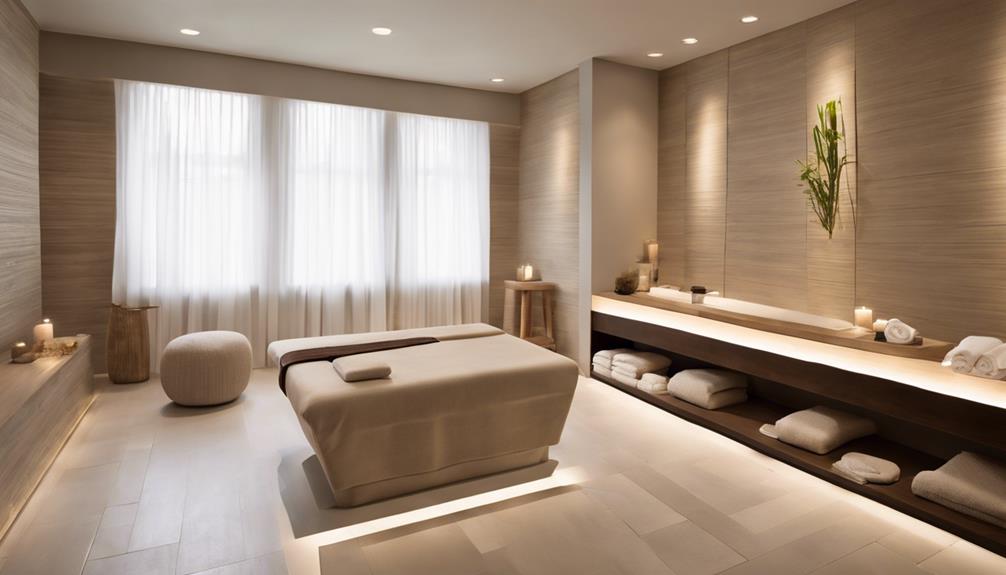
Emerging from the tranquil haven of the Urban Oasis Spa spatial concept, the minimalist spa retreat arrangement epitomizes simplicity, functionality, and tranquility in its design ethos. Clean lines, neutral color palettes, and uncluttered spaces define this minimalist approach, creating a sense of calm and relaxation. The floor plans are thoughtfully crafted to prioritize open layouts, allowing natural light to flood the space and ergonomic furniture to enhance comfort. Storage solutions are seamlessly integrated to maintain the minimalist aesthetic, ensuring a clutter-free environment that promotes serenity.
Quality takes precedence over quantity in this design philosophy, with a focus on delivering a peaceful and unobtrusive spa experience for guests. Every element is carefully curated to contribute to the overall sense of tranquility, from the layout to the choice of materials. The minimalist spa retreat arrangement offers a harmonious blend of functionality and aesthetics, setting the stage for a truly rejuvenating experience.
Scandinavian Spa Interior Scheme

Crafted with a blend of minimalist elegance and natural elements, the Scandinavian Spa Interior Scheme captures the essence of tranquility and comfort through its clean lines and light color palette. In Scandinavian spa designs, simplicity is key, reflecting a sense of calmness and serenity through the following elements:
- Minimalist Designs: Embracing clean lines and uncluttered spaces.
- Light Color Palette: Incorporating whites, light grays, and pale woods to create a peaceful ambiance.
- Functional Furniture: Prioritizing comfort and practicality with ergonomic pieces.
- Nature Integration: Bringing the outdoors inside with plants and natural light.
Textures like natural stone, wood, and organic fabrics are also utilized to enhance warmth and relaxation within the spa environment. This interior scheme not only promotes a sense of well-being but also offers a modern and innovative approach to spa design that resonates with those seeking a harmonious blend of nature and sophistication.
Frequently Asked Questions
How to Design a Spa Room?
Designing a spa room involves considering space layout, color schemes, lighting, and comfort elements. We prioritize efficient circulation, soothing aesthetics, proper ventilation, storage solutions, and peaceful acoustics. Our approach ensures a serene environment for clients and therapists alike.
How to Design Floor Plans?
When designing floor plans, we carefully consider traffic flow and functionality, ensuring each area serves its purpose efficiently. Strategically placing treatment rooms, relaxation zones, and staff facilities optimizes space. Privacy and comfort are prioritized through separate spa activity zones.
How Do I Create a Floor Plan in Canva?
We easily create a floor plan in Canva by utilizing its user-friendly interface and drag-and-drop features. With Canva's templates and customization options for walls, doors, windows, and furniture, designing becomes effortless.
How Can I Draw My House Plans for Free?
We can draw house plans for free using online tools like Floorplanner or RoomSketcher. With drag-and-drop features and tutorials, creating accurate plans is as easy as pie. Let's get creative with our designs!
Conclusion
In conclusion, designing a spa floor plan is like putting together a puzzle – each piece carefully selected to create a harmonious and luxurious space.
It's all about finding the right balance between functionality and ambiance, creating an oasis where clients can relax and rejuvenate.
So grab your pens and get ready to sketch out your dream spa layout, because the possibilities are endless!
Let's turn up the heat and make this spa design sizzle!
- About the Author
- Latest Posts
Introducing Ron, the home decor aficionado at ByRetreat, whose passion for creating beautiful and inviting spaces is at the heart of his work. With his deep knowledge of home decor and his innate sense of style, Ron brings a wealth of expertise and a keen eye for detail to the ByRetreat team.
Ron’s love for home decor goes beyond aesthetics; he understands that our surroundings play a significant role in our overall well-being and productivity. With this in mind, Ron is dedicated to transforming remote workspaces into havens of comfort, functionality, and beauty.
-
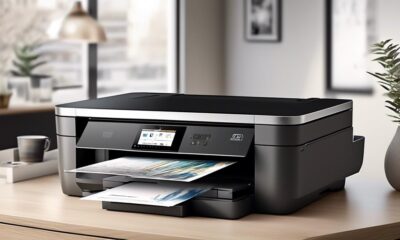
 Vetted2 days ago
Vetted2 days ago15 Best Printers of 2024: Top Picks and Expert Reviews
-
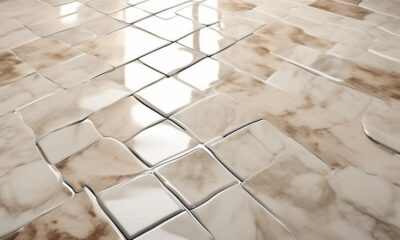
 Vetted4 days ago
Vetted4 days ago15 Best Tile Sealers for Long-Lasting Protection and Shine
-

 Vetted1 week ago
Vetted1 week ago15 Best Smelling Floor Cleaners That Will Leave Your Home Fresh and Inviting
-
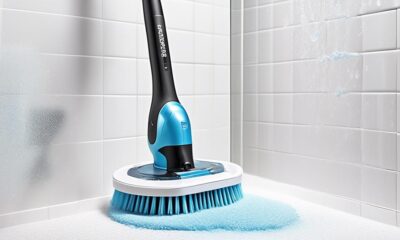
 Vetted6 days ago
Vetted6 days ago14 Best Power Scrubbers for Showers That Will Transform Your Cleaning Routine
-

 Mardi Gras Decoration22 hours ago
Mardi Gras Decoration22 hours agoWhat Do the Symbols of Mardi Gras Mean?
-
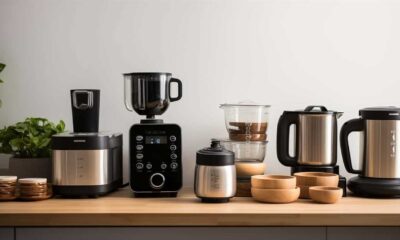
 Appliances4 days ago
Appliances4 days ago5 Best Energy-Efficient Stainless Steel Fridges 2023
-
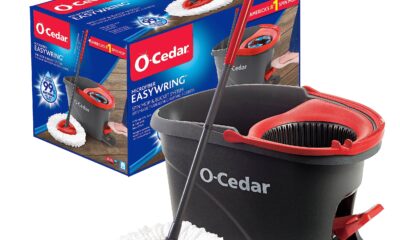
 Vetted4 weeks ago
Vetted4 weeks agoBest Mop for Sparkling Clean Floors in 2024
-
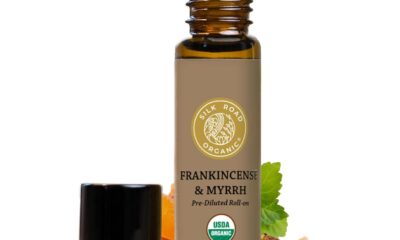
 Vetted4 days ago
Vetted4 days agoBest Essential Oil Brand: Top Picks for 2024

























